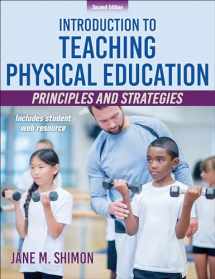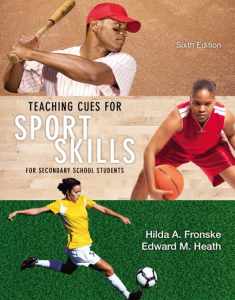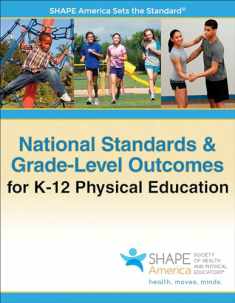
Introduction to Teaching Physical Education: Principles and Strategies
ISBN-13:
9781492566397
ISBN-10:
149256639X
Edition:
Second
Author:
Jane M. Shimon
Publication date:
2019
Publisher:
Human Kinetics
Format:
Paperback
256 pages
Category:
Coaching
,
Education Theory
,
Schools & Teaching
,
Instruction Methods
FREE US shipping
Rent
35 days
Due May 31, 2024
35 days
from $16.82
USD
Book details
ISBN-13:
9781492566397
ISBN-10:
149256639X
Edition:
Second
Author:
Jane M. Shimon
Publication date:
2019
Publisher:
Human Kinetics
Format:
Paperback
256 pages
Category:
Coaching
,
Education Theory
,
Schools & Teaching
,
Instruction Methods
Summary
Introduction to Teaching Physical Education: Principles and Strategies (ISBN-13: 9781492566397 and ISBN-10: 149256639X), written by authors
Jane M. Shimon, was published by Human Kinetics in 2019.
With an overall rating of 4.4 stars, it's a notable title among other
Coaching
(Education Theory, Schools & Teaching, Instruction Methods) books. You can easily purchase or rent Introduction to Teaching Physical Education: Principles and Strategies (Paperback, New) from BooksRun,
along with many other new and used
Coaching
books
and textbooks.
And, if you're looking to sell your copy, our current buyback offer is $21.55.
Description
Introduction to Teaching Physical Education: Principles and Strategies—already a popular text for students considering majoring or minoring in physical education—is now even stronger in this new second edition.
Three strengths that set the second edition of this book apart from its competitors are its sole focus on physical education, the depth and breadth of physical education topics it covers, and its affordability. It features the essential content that students need to build a strong base of instructional skills and an understanding of the field—and it does so in an engaging manner to get students excited about teaching physical education.
Introduction to Teaching Physical Education, Second Edition, delves into the theoretical, practical, and inspirational aspects of teaching physical education. Students can explore the field’s history, purpose, and concepts as well as learn teaching skills, examine instructional scope and sequence, and learn about the responsibilities of a teacher. They’ll also learn about teaching duties, motivation and behavior management strategies, assessment, lesson planning, technology and online resources, and careers in the field.
Updates and New Material
Introduction to Teaching Physical Education is updated to reflect the significant changes that have occurred in the field over the past few years, including SHAPE America’s National Standards and Grade-Level Outcomes for K–12 Physical Education, the SHAPE America Physical Education Teacher Education (PETE) guidelines, and more.
To keep up with the changes in the field, author Jane Shimon has revised or added new material:
Book Organization
Introduction to Teaching Physical Education is organized into four parts. Part I outlines the history of physical education, including the two main systems that served as the profession’s foundation; influential concepts and people; and current advancements. It also discusses the purpose of physical education and highlights the many teaching and nonteaching duties of physical educators. Part II presents the details for teaching physical education, including the steps to organizing and instructing in the classroom and the gymnasium. It also looks at motivational theories and how to prevent misbehavior and positively manage student behavior.
In part III, students learn about planning lessons and assessing outcomes. They examine scope and sequence, learn how to develop appropriate objectives and quality lesson plans, and explore assessment and rubric design. Part IV affords students insight into current technology issues that can be used to enhance physical education, and it explores the career options available.
Ancillaries
Introduction to Teaching Physical Education offers several ancillary materials:
Introduction to Teaching Physical Education, Second Edition, will help students gain the knowledge and skills they need as they pursue their entry into the teaching profession, providing them with a springboard to advance in their coursework. This complete but concise text supplies the perfect introduction to the physical education field, covering the essentials in an engaging and informative way as students learn to apply the principles of teaching physical education.
Three strengths that set the second edition of this book apart from its competitors are its sole focus on physical education, the depth and breadth of physical education topics it covers, and its affordability. It features the essential content that students need to build a strong base of instructional skills and an understanding of the field—and it does so in an engaging manner to get students excited about teaching physical education.
Introduction to Teaching Physical Education, Second Edition, delves into the theoretical, practical, and inspirational aspects of teaching physical education. Students can explore the field’s history, purpose, and concepts as well as learn teaching skills, examine instructional scope and sequence, and learn about the responsibilities of a teacher. They’ll also learn about teaching duties, motivation and behavior management strategies, assessment, lesson planning, technology and online resources, and careers in the field.
Updates and New Material
Introduction to Teaching Physical Education is updated to reflect the significant changes that have occurred in the field over the past few years, including SHAPE America’s National Standards and Grade-Level Outcomes for K–12 Physical Education, the SHAPE America Physical Education Teacher Education (PETE) guidelines, and more.
To keep up with the changes in the field, author Jane Shimon has revised or added new material:
- New Teachers Talking Teaching tips from national and district Teachers of the Year from around the country
- A new section addressing attentional focus and teaching cues
- New content on student engagement, differentiated instruction, and inclusion
- New material on technology, particularly regarding the use of mobile devices in physical education
- Extended information on writing lesson objectives and on the use of formative assessments
Book Organization
Introduction to Teaching Physical Education is organized into four parts. Part I outlines the history of physical education, including the two main systems that served as the profession’s foundation; influential concepts and people; and current advancements. It also discusses the purpose of physical education and highlights the many teaching and nonteaching duties of physical educators. Part II presents the details for teaching physical education, including the steps to organizing and instructing in the classroom and the gymnasium. It also looks at motivational theories and how to prevent misbehavior and positively manage student behavior.
In part III, students learn about planning lessons and assessing outcomes. They examine scope and sequence, learn how to develop appropriate objectives and quality lesson plans, and explore assessment and rubric design. Part IV affords students insight into current technology issues that can be used to enhance physical education, and it explores the career options available.
Ancillaries
Introduction to Teaching Physical Education offers several ancillary materials:
- A web resource featuring chapter overviews, definitions of key terms, and supplemental materials such as worksheets, lesson plan templates, and short situational studies
- An instructor guide with a sample course syllabus, chapter overviews, key terms, discussion questions, learning activities, and more
- A test package with more than 200 true-or-false and multiple-choice questions
- A PowerPoint presentation package with more than 200 slides, including select illustrations and tables
Introduction to Teaching Physical Education, Second Edition, will help students gain the knowledge and skills they need as they pursue their entry into the teaching profession, providing them with a springboard to advance in their coursework. This complete but concise text supplies the perfect introduction to the physical education field, covering the essentials in an engaging and informative way as students learn to apply the principles of teaching physical education.


We would LOVE it if you could help us and other readers by reviewing the book
Book review

Congratulations! We have received your book review.
{user}
{createdAt}
by {truncated_author}




